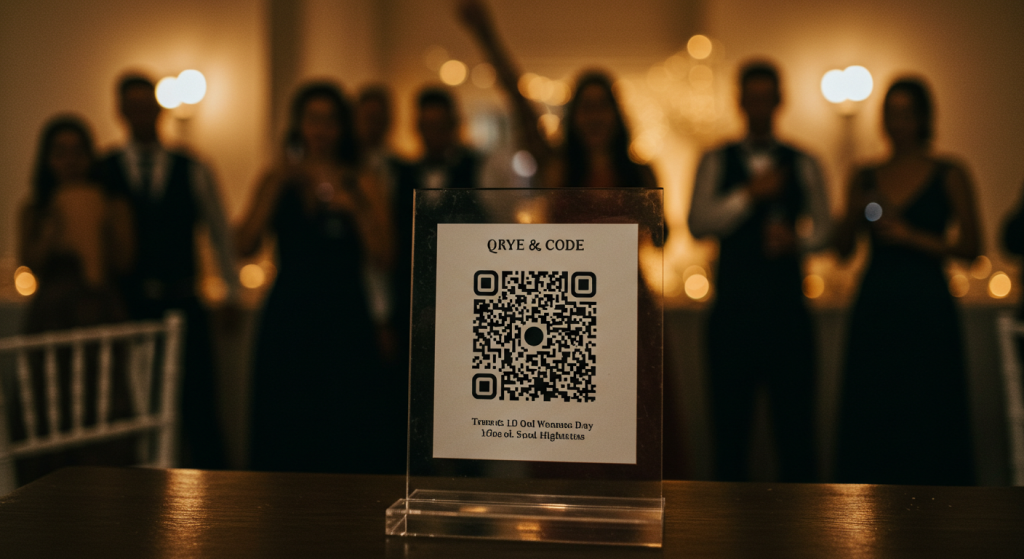From Weddings to Corporate Parties: How QR Code Cards Transform Photo Sharing

In a world where every event—big or small—is documented by dozens of smartphones, there’s a universal truth: the best memories are often the ones you don’t plan for. A CEO’s impromptu dance at a holiday party, a toddler stealing the spotlight at a birthday celebration, or a sunset toast during a destination wedding—these moments are fleeting, but they define the soul of an event. The challenge? Capturing them all in one place without drowning in chaos.
Enter QR code cards, a versatile tool that’s redefining photo sharing for every type of gathering. From black-tie weddings to team-building retreats, these pocket-sized solutions are bridging the gap between spontaneity and organization. Let’s explore how they’re becoming the unsung hero of modern events.
The Universal Photo-Sharing Problem
No matter the event, hosts face the same hurdles:
- Fragmented memories: Photos end up scattered across texts, emails, and social media.
- Tech barriers: Guests resent downloading apps or resetting passwords.
- Missed perspectives: Only a fraction of candid moments make it to the host.
QR code cards tackle these issues head-on by offering a one-size-fits-all solution.
What Are QR Code Cards?
QR code cards are physical or digital cards embedded with a unique QR code that links to a private online gallery. Guests scan the code with their smartphone camera to upload photos and videos instantly—no apps, accounts, or logins required.
The result? A centralized hub where all event memories live, organized and accessible to everyone.
How QR Code Cards Adapt to Any Event
1. Weddings: Curate a Collaborative Love Story
While photographers focus on staged shots, guests capture the raw emotion: shaky-handed ceremony videos, behind-the-scenes dressing room laughs, and dance-floor chaos.
How to Use Them:
- Print QR codes on wedding favors, programs, or cocktail napkins.
- Create a live slideshow during the reception using real-time uploads.
Pro Tip: Pair QR codes with a polaroid guestbook. Guests can tape physical photos next to their digital uploads for a hybrid keepsake.
2. Corporate Events: Boost Engagement and Branding
From product launches to conferences, businesses use QR code cards to:
- Collect photos for social media recaps and annual reports.
- Encourage team bonding by crowdsourcing memories from workshops or retreats.
Example: A tech company used Iconmoments’ QR code cards at a summit, gathering over 1,200 photos for their post-event campaign. Attendees loved seeing their contributions featured on the company’s LinkedIn page.
Pro Tip: Brand the gallery and QR cards with your company logo for a polished touch.
3. Parties and Milestones: Turn Guests into Co-Stars
Birthdays, graduations, and anniversary parties thrive on guest interaction. QR code cards let attendees:
- Share video messages for the guest of honor.
- Upload group selfies to a live feed projected on a screen.
Pro Tip: For a birthday, use the QR code gallery to create a surprise “memory video” to play at the end of the night.
4. Vacations and Reunions: Simplify Group Travel Memories
Family reunions or group trips often leave photos trapped on individual devices. QR code cards solve this by:
- Creating a shared album for sunset snaps, hike fails, and inside jokes.
- Letting everyone access the same pool of memories post-trip.
Pro Tip: Print QR code stickers for luggage tags or water bottles to keep the gallery top-of-mind.
Why QR Code Cards Work for Every Occasion
They’re Guest-Proof
QR codes require zero technical skill. Whether your crowd is 8 or 80, scanning is intuitive. At a recent family reunion, 85-year-old Frank uploaded his first smartphone photo—a blurry but beloved shot of his grandkids.
They Save Time (and Sanity)
Hosts no longer waste hours chasing down photos. One bride received 900+ images via QR codes within 24 hours of her wedding—without sending a single text.
They Protect Privacy
Private galleries let hosts control who sees what. For corporate events, this means keeping internal photos off public social media. For weddings, it avoids awkward “delete this now” requests.
How to Implement QR Code Cards Like a Pro
- Customize for the Occasion
- Weddings: Opt for elegant foil-stamped cards.
- Corporate events: Use sleek, branded designs.
- Parties: Get playful with neon colors or quirky shapes.
- Strategic Placement
- Position QR codes where guests naturally pause: bars, buffet lines, or photo booths.
- For multi-day events (like conferences), refresh the code’s placement daily to remind guests.
- Incentivize Participation
- Offer a prize for the “best upload” (e.g., a funniest photo contest at a birthday party).
- For corporate events, raffle a gift card to boost engagement.
The Secret to Their Success? Human Connection
QR code cards don’t just collect photos—they foster a sense of community. When guests see their photos added to a shared gallery, they feel like part of the event’s story. At a charity gala, organizers noted that guests who uploaded photos were 3x more likely to donate, citing a “deeper emotional connection” to the cause.
The Future of Event Photography
As hybrid and virtual events grow, QR code cards will evolve too. Imagine:
- AR integration: Scanning a code unlocks immersive photo filters tied to the event theme.
- AI curation: Algorithms pick the best guest photos to auto-generate highlight reels.
But for now, their simplicity remains their strength.
Final Thought
QR code cards prove that great ideas don’t need to be complicated. By meeting guests where they are—armed with smartphones and a desire to connect—they turn every event into a collaborative masterpiece. Whether you’re planning a board meeting or a beachside vow exchange, this tiny tool ensures no memory slips through the cracks.
Pro Tip: After the event, use your gallery to create thank-you cards, photo books, or a recap video. It’s the perfect way to close the loop!





